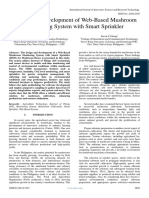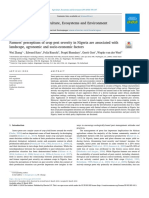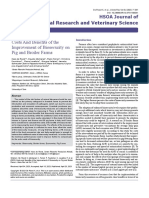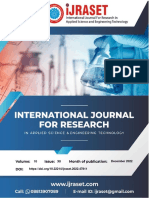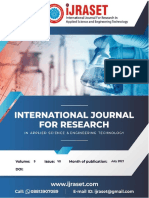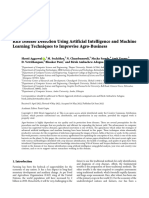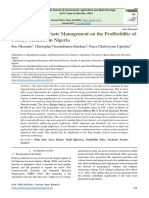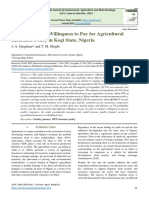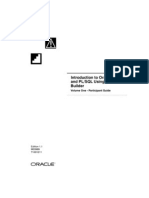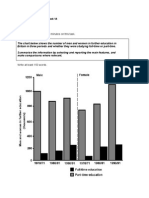Professional Documents
Culture Documents
Biosecurity Assessment of Layer Farms in Sierra Leone Using Biocheck. UGent Scoring Tool
Copyright
Available Formats
Share this document
Did you find this document useful?
Is this content inappropriate?
Report this DocumentCopyright:
Available Formats
Biosecurity Assessment of Layer Farms in Sierra Leone Using Biocheck. UGent Scoring Tool
Copyright:
Available Formats
Volume 7, Issue 7, July – 2022 International Journal of Innovative Science and Research Technology
ISSN No:-2456-2165
Biosecurity Assessment of Layer Farms in Sierra
Leone using Biocheck. UGent Scoring Tool
Abdul Rahman Sesay
Department of Animal Science, Njala Campus, Njala University, Sierra Leone
Abstract:- Evaluation of the biosecurity of layer farms is any intervention to increase adherence to biosecurity measures
essential for successfully controlling and preventing [6]. In addition, only a few studies adequately relate
poultry diseases. The objective of this study is to evaluate production performance to biosecurity using quantitative data
the biosecurity of layer farms in Sierra Leone using the [7]. The Ghent University in Belgium developed Biocheck.
Biocheck. UGent scoring system. This online biosecurity UGent score tool, a risk-based and independent system to
evaluation tool assesses the farm's biosecurity compliance. evaluate the quality of on-farm biosecurity. Biocheck. UGent
The data was collected from 38 layer farms in four scoring tool has been used in various European countries to
provinces and one area in the country. The data were assess biosecurity in livestock farms [8].
encoded online to provide ratings for each farm's
biosecurity. The online algorithm decoded and provided Finding out the actual state of biosecurity in layer farms
individual farm biosecurity scores across all categories and may be the first step in implementing the necessary
subcategories. The study found that the overall average adjustments to make farms more resistant to the threat of
biosecurity of the layer farms was (67%). The average disease invasion [9]. Increasing adherence to biosecurity
external and internal biosecurity scores for layer farms are measures is widely acknowledged as the most effective
(64%) and (70%), respectively. The North West province method for reducing the risk of disease [10,9]. Biosecurity has
has the highest score of total average biosecurity at (73%), been of utmost significance to the expansion of the poultry
followed by the Southern province at (71%). The business since its procedures considerably minimize or restrict
subcategories with the highest external biosecurity scores the introduction of diseases into poultry farms [7].
were farm location (92%), material supply (91%), Nevertheless, compliance with biosecurity measures among
purchase of laying hens (84%), infrastructure and poultry farms is often low, especially in developing nations,
biological vector (69%), and purchase of day-old chicks despite these sound effects of biosecurity measures [11]. Low
(66%), while the category with the lowest external biosecurity levels expose chickens' flocks to various infectious
biosecurity score were visitors and farmworkers, removal illnesses, which are then linked to significant economic losses
of manure and carcasses, feed and water, and [12]. Therefore, providing farmers with accessible and
depopulation and transportation of hens. The internal valuable biosecurity knowledge is vital to implementing and
biosecurity subcategories washing and disinfection (87%) keeping their farms free from disease threats [13,7]. No study
and egg management (63%) obtained the highest average has been devoted to assessing the biosecurity status of layer
score, while disease management and material and farms in Sierra Leone. The study aims to evaluate biosecurity
measure between compartments received a lower score. To status in layer farms using the Biocheck. UGent scoring
manage and prevent poultry diseases on layer farms, the system.
biosecurity subcategories that received the lowest scores
should be improved. The nation's relevant institutions II. METHODOLOGY
should monitor and enforce biosecurity compliance in
layer farms. A. Study area
Sierra Leone is located on Africa's west coast, covers 72
Keywords:- Biocheck. Ugent, Biosecurity Scoring Tool, 000 km2, and has a population of 7.65 million as of 2018 [14].
External Biosecurity, Internal Biosecurity, Layer Farm. The country is bordered on the east and north by the Republic
of Guinea and on the south by the Republic of Liberia. Eastern
I. INTRODUCTION Province, Northern Province, Southern province, and Western
area are the three provinces and one area that make up the
The term "biosecurity" refers to a comprehensive set of nation. The provinces are further divided into districts and
actions to reduce the risk of introducing and spreading chiefdoms, each of which has several villages. The elevation
pathogens [1]. It is an efficient and affordable method of of the terrain varies from less than 50 meters above sea level
controlling poultry diseases [2,3]. Biosecurity is divided into in coastal parts to more than 500 meters in the highlands.
two major components such as external and internal Sierra Leone has a tropical monsoon climate with two distinct
biosecurity. Internal biosecurity tries to stop the spread of seasons: rainy season (May to October) and dry season
viruses within the herd, while external biosecurity aims to (November to April). Annual rainfall is around 3000 mm on
keep pathogens out of the flock [4,5]. Previous research has average, ranging from 2000 mm in the north to 4000 mm in
proven that a high level of animal biosecurity improves animal the south. The rainfall distribution is unimodal, with August
health and technical and economic performance and reduces being the wettest month. Rainfall onset varies greatly, which
antibiotic use [6]. The most practical and cost-effective has substantial implications for the prevailing practice of rain-
method of disease prevention in layer farms continues to be fed agricultural production. Agriculture is the country's main
IJISRT22JUL323 www.ijisrt.com 130
Volume 7, Issue 7, July – 2022 International Journal of Innovative Science and Research Technology
ISSN No:-2456-2165
economic engine, with crops, livestock, forestry production, of poultry experts calculated the relative relevance of each
and fisheries employing around two-thirds of the working subcategory for disease transmission and assigned it a unique
force and accounting for more than 60% of GDP in 2020 [15]. weight factor [18]. For internal and external biosecurity, the
Rice is an essential food crop, followed by cassava and potato. final score can vary from zero, which denotes a complete lack
Mining also contributes significantly to Sierra Leone's of the indicated biosecurity measures, to 100, which denotes a
economy; it comes second after agriculture [16]. full implementation of the described methods. The total
biosecurity score is calculated as the average internal and
B. Data collection exterior biosecurity values [6].
The biosecurity of layer farms was measured using the
Biocheck. UGent score system. It is a reliable, repeatable, and D. Data analysis
valid risk-based scoring method for measuring on-farm Biochek. UGent, a risk-based scoring instrument created
biosecurity [3,17]. Their website by the University of Ghent, was utilized to evaluate farm
(https://biocheckgent.com/en/surveys) provides free access to biosecurity. The data of the completed surveys were encoded
various biosecurity questionnaires. The biosecurity online to generate ratings for each farm's biosecurity. The
questionnaire for layer farms was acquired from their website algorithm decoded and provided individual farm biosecurity
and reproduced for the research. Layer farms in different scores across all categories and subcategories. The data were
provinces of the nation were selected. A total of 38 layer farms further compiled in Microsoft Office Excel 2016 for
in four provinces and one area of the country, including the consolidation and statistical analysis. For farm characteristics,
Northern province (n=9), North West province (n=4), means standard deviation and range were obtained, while the
Southern province (n=7), Eastern province (n=6), and Western percentage and graphs for the external and internal biosecurity
area (n=12), volunteered to take part in the study. A contact scores. In addition, a t-test was conducted to compare the total
person, often the farm manager or owner, was interviewed biosecurity scores of layer farms in the external and internal
during site visits to each farm. Most interviews took place in biosecurity subcategories to the global averages.
the farms' offices, and some had to be conducted outside the
gates due to the risk of disease introduction. The face-to-face III. RESULT AND DISCUSSION
interviews were conducted from January to August 2021.
A. Farm characteristics
C. Quantification of biosecurity Table 1 displays the characteristics of the surveyed layer
The online tool Biocheck. UGent offers a risk-based farms. All the layer farms included in the study use a housing
assessment that considers the relative significance of the structure consisting of deep litter. The majority are small-scale
various biosecurity measures [6]. The resulting scores for each layer farms, with a mean flock size of 3034.2 birds and a range
farm enable evaluation of the biosecurity compliance's strong of 500-6200. The average years of experience of the persons
and weak aspects, which can serve as the foundation for in charge of the farms were 15.8 years, ranging from 5-26
recommendations to strengthen biosecurity. It consists of 120 years. The average number of layer farmworkers was 11.2,
dichotomous or trichotomous questions broken down into ranging from 7 to 16. The oldest structure in the layer farms
several internal and external biosecurity subcategories. There has a mean age of 18.1 years and a range of 7 to 30 years, while
are 2 to 16 questions in each subcategory. The score for each the newest building has a mean age of 4.7 years and a range of
question is multiplied by a weight factor based on the 2 to 8 years.
significance of each biosecurity measure [18,3]. A broad panel
Table 1: Characteristics of layer farms
Farm characteristics Mean ± S.d. Range
Flock size 3034.2 ±1216.2 500-6200
Years in keeping birds 15.8±5.3 6-26
Number of farmworkers 11.2±2.4 7-16
Years of the oldest building 18.1±5.9 7-30
Years of the newest building 4.7±1.5 2-8
Source: Field survey, 2021
B. Provincial total average biosecurity score of layer farms provinces, the North West province (73%) earned the highest,
Figure 1 shows the overall biosecurity scores for the four followed by the Southern province (71%), Western area
provinces and one area of the country. The average biosecurity (66%), Northern province (65%), and Eastern province (62%).
score for layer farms in the country was (67%) slightly higher Even though the provincial scores were greater than the global
than the total world average of (61%). In terms of the overall total biosecurity scores, there was no discernible difference
average biosecurity score of layer farms in the country's between the provinces' total biosecurity scores.
IJISRT22JUL323 www.ijisrt.com 131
Volume 7, Issue 7, July – 2022 International Journal of Innovative Science and Research Technology
ISSN No:-2456-2165
100
90
80 [] 73
70 [] []
[]
60
Score
50
40
30
20
10
0
Western area Northern Southern Eastern Noth West
province province province province
Provincial total biosecurity Global total biosecurity
Fig 1: Provincial total average biosecurity score of layer farms
C. Provincial average external biosecurity score of layer province is the highest (71%), followed by the North West
farms province (69%), the Western region (65%), and the Northern
Figure 2 displays the external biosecurity scores acquired province (62%). The external biosecurity score of the Eastern
by layer farms in each of the four provinces and one area of province (54%) is considerably lower than the global average.
the country. The average biosecurity score for the Southern
100
90
80 71 69
70 65 62
54
60
Score
50
40
30
20
10
0
Western area Northern Southern Eastern North West
province province province province
Provincial average Global average
Fig 2: Provincial average external biosecurity score of layer farms
D. provincial average internal biosecurity score of layer province (69%), the northern province (68%), and the western
farms area (66%). There is also no substantial difference between
For internal biosecurity figure 3, the four provinces any province's internal biosecurity scores. Therefore, it may be
perform marginally better than the global average, with the concluded that layer farmers adopt a similar management
North West province placing best with a score of (76%), method nationwide.
followed by the Southern province (70%), the Eastern
IJISRT22JUL323 www.ijisrt.com 132
Volume 7, Issue 7, July – 2022 International Journal of Innovative Science and Research Technology
ISSN No:-2456-2165
100
90
80 76
68 70 69
70 66
60
Score
50
40
30
20
10
0
Western area Northern Southern Eastern North West
province province province province
Provincial average Global average
Fig 3: provincial average internal biosecurity score of layer farms
E. External subcategory biosecurity score of layer farms vector (69%), purchase of day-old chicks (66%), and
The overall average biosecurity ratings for the exterior transportation of eggs (62%). Visitors and farmworkers
categories of all layer farms were (64%) (figure 4). Compared (57%), disposal of manure and corpses (43%), feed and water
to the global average biosecurity score, the average (41%), and depopulation and transportation of chickens (41%)
performance of all farms in the subcategory of the external all score worse than the global average (36%). Due to their
biosecurity score demonstrates that the farms perform best in lower scores than the global average in numerous biosecurity
the categories of farm location (92%), material supply (91%), categories, layer farms must improve.
purchase of laying hens (84%), infrastructure and biological
Overall farms average Global average
100 91 92
90 84
80
66 69
70 62 57 64
60
41 43
Score
50
40 36
30
20
10
0
Fig 4: External subcategory biosecurity score of layer farms
IJISRT22JUL323 www.ijisrt.com 133
Volume 7, Issue 7, July – 2022 International Journal of Innovative Science and Research Technology
ISSN No:-2456-2165
F. Internal subcategory biosecurity score of layer farms (63%) are superior to the worldwide average. Conversely,
Figure 5 shows that all farms' average performance in disease management (69%) and material and measurements
internal biosecurity categories was (70%). The performance of between compartments (62%) are lower than the global
all farms in the internal biosecurity subcategory demonstrates average. As the performance of layer farmers is below the
that cleaning and disinfection (86%) and egg management global average, there is room for improvement in this sector.
100
Overall farms average Global average
90 86
80
69 70
70 62 63
60
Score
50
40
30
20
10
0
Fig 5: Internal subcategory biosecurity score of layer farms
G. t-test analysis of the overall average scores of layer farms the subcategory's global average. In addition, the country's
for the different subcategories of biosecurity and global layer farms have space for development in the following
averages subcategories: acquisition of laying hens; depopulation and
Table 2 displays a t-test comparing the global and overall transportation of chickens; disposal of excrement and corpses;
average scores for the various subcategories of biosecurity. visitors and farm employees; and infrastructure and biological
Globally, the average score was (61%), with exterior vectors. This is because the average score in these
biosecurity scoring (56%) and internal biosecurity scoring subcategories was significantly lower than the already
(65%). Similarly, the overall average ratings for the moderately low global average. The internal biosecurity
participating layer farms were (67.2%) percent for total subcategory cleaning and disinfection scores are substantially
average biosecurity, (64.4%) for external biosecurity, and higher than the global average (p=0.001). However, the scores
(70%) for internal biosecurity. In the case of layer farms, the for egg management are not statistically higher but are
total external biosecurity score of the subcategory's nevertheless higher than the global average. To boost
procurement of day-old chicks (p = 0.001), transport of eggs biosecurity, layer farmers should strengthen internal
(p = 0.001), material supply (p = 0.001), and location of the biosecurity measures, such as disease management and
farm (p = 0.001) was statistically significant and higher than materials and measures between compartments.
Table 2: t-test analysis of the overall average scores of layer farms for the different subcategories of biosecurity and global
averages.
IJISRT22JUL323 www.ijisrt.com 134
Volume 7, Issue 7, July – 2022 International Journal of Innovative Science and Research Technology
ISSN No:-2456-2165
Subcategory Global average Overall farms average P-value
External biosecurity
Purchase of 1-day-old chicks 50 65.6 0.001
Purchase of laying hens 72 84.0 0.013
Depopulation and transport of hens 57 36.2 0.040
Transport of eggs 41 62.4 0.001
Feed and water 50 41.4 0.103
Removal of manure and carcasses 45 43.4 0.695
Visitors and farmworkers 62 57.4 0.378
Material supply 70 90.8 0.001
Infrastructure and biological vectors 64 69.0 0.298
Location of the farm 63 92.4 0.001
Subtotal 56 64.4 0.025
Internal biosecurity
Disease management 70 69.4 0.902
Cleaning and disinfection 65 86.0 0.001
Materials and measures between compartments 64 61.8 0.971
Egg management 58 62.6 0.800
Subtotal 65 70.0 0.022
Total 61 67.2 0.013
Source: Authors computation, 2021
H. Detailed description of layer farms external biosecurity was possible on (78.4%) of the layer farms. However, while
loading the birds onto the vans, only (42%) of the farms
1). Purchase of day-old chicks provided farm-specific or disposable clothing and shoes to the
Over the past two years, (93.5%) of layer farms have not drivers and capturing crews. When protective clothing is not
changed their supply of chicks. Suppliers of day-old chicks worn on the farm by farmworkers or visitors, the danger of
transport chicks directly to the farms for (95%) of the layer disease spread increases dramatically [19]. Wearing protective
farms. Regarding delivery trucks for most farms, (92%) do not farm clothing should be enforced severely.
include chicks for other farms. Most of these farms' delivery
van drivers do not return to the farm with empty containers 4). Transport of eggs
after making deliveries to other farms. Before entering the Most layer farms (80%) have dedicated spaces on the
layer farms, delivery trucks were cleaned and sanitized in farm to store eggs. Eggs are available for sale on the farm, and
(89%) of the farms. This is a good practice since the frequent visitors are welcome to come to make their purchases there.
movement of trucks from one farm to another might raise the The transport of pathogens by humans is one of the greatest
danger of disease spreading [3]. challenges to biosecurity. A significant aspect of a good
biosecurity program is the restriction of superfluous human
2). Purchase of pullets. traffic [3]. Layer farms should limit visitor access and ensure
Most farmers (86.3%) have not changed their pullet that the sale of eggs is restricted or eliminated. Some layer
suppliers in the last two years. Most of the farms had suppliers farmers (78.3%) do not clean or disinfect the truck where eggs
deliver pullets directly to the farms. Pullets were always sent are transported. In most layer farms, (93%) of the truck drivers
first to layer farms (97%) before being given to other farms. are not permitted direct access to the egg storage facility;
Delivery van drivers do not return to these farms with empty instead, the farmworkers put the eggs directly onto the truck.
boxes after making deliveries to other farms. The layer farms
(93.6%) sanitize delivery trucks before allowing them to 5). Feed and water supply.
access the farm. When you buy animals, you run the danger of Most layer farms (92%) did not have distinct clean and
introducing pathogens. Protocols should be in place to unclean regions. To defend against water, birds, and vermin,
guarantee that new animal purchases do not introduce new (86.2%) of the layer farms had well-sealed feed storage spaces.
infections or enable them to circulate freely throughout the The chicken buildings were not accessible to feed providers.
farms [6]. Around (80%) of the layer farms had their feed storage
facilities filled more than 25 times yearly. Feeds are delivered
3). Transport of live animals. in bags by private feed mills regularly. This poses a significant
It's crucial to clean and disinfect transport trucks properly concern since the more frequently transport trucks move, the
to avoid disease transmission, especially if they're coming greater the potential of disease pathogens being transported
from neighboring farms [3,6]. Upon arrival, (89%) of the layer with them. Because feeds can be contaminated along the route
farms cleaned their transport cars. Individuals and dealers to manufacture, transit, or storage, this increases the possibility
were not allowed to enter the stables where direct interaction of transmission [19]. Feed silos provide better protection
IJISRT22JUL323 www.ijisrt.com 135
Volume 7, Issue 7, July – 2022 International Journal of Innovative Science and Research Technology
ISSN No:-2456-2165
against rats and other pests than feeds stored in warehouses one animal caretaker is in charge of many poultry houses at
[20,21]. Over (84.6%) of the farms had several feed suppliers. once. Pathogens can easily spread between chicken
Many feed sources exacerbate the problem of probable feed populations within and between farms [29].
contamination and disease transmission. Most layer farms
(94.5%) have never conducted a bacteriology examination of 8). Supplies and equipment
their drinkable water. Because most farms are small-scale The majority of layer farms (98%) utilize just their
layer farms, they do not pay much attention to water quality. materials and equipment. They didn't lend any of their goods
Some people utilize untreated well water, which is relatively or equipment to another farm. The exclusive use of supplies
easy. It has been demonstrated that bacteria may quickly and equipment prevents spreading of diseases that might
contaminate drinking water [19]. Dewulf et al. [6] suggested otherwise occur if the equipment was shared [24]. However,
that drinking water facilities be well-managed, with frequent (75.4%) of layer farms do not make their feed. As a result,
quality and safety audits. most farms will have to rely on feed millers to produce feed
regularly. Excessive movement of delivery trucks into and out
6). Removal of manure and dead animals. of layer farms, especially more than twice per month, will
In most layer farms, (90.5%) manure was removed after undoubtedly introduce disease.
each production cycle. Layer farm manure is held in a structure
or open space before being sold to other farms as an organic 9). Infrastructure and biological vectors
fertilizer for vegetable production. A few farmers continue to Most layer farms (86.6%) had a robust infrastructure and
dump manure in the surrounding areas. This can increase the could keep biological vectors at bay. However, just (13.4%) of
chance of spreading infections such as Gumboro, Avian the layer farms reported vermin difficulties, and only around
Influenza, and Infectious Bronchitis [19]. This also opens the (5%) of them had established a vermin management program.
door to human interaction and the danger of infection Rodents are crucial in several pathogenic pathogens'
transmission, providing a biosecurity concern [22]. mechanical and biological transmission. An effective control
Composting and anaerobic storage are required before using program is essential to keep vermin under control. Increasing
manure as organic fertilizer or spreading it on the crops [23]. their compliance will undoubtedly lower the number of
The birds are inspected twice daily, and any deceased birds are disease-carrying rodents on their farms [30]. Most layer farms
taken, placed in a designated location, and disposed of (76.5%) have not had their immediate exteriors paved and
immediately. There is no suitable carcass storage or disposal cleaned, while only (23.5%) of the farms' exteriors are paved
mechanism in place. As quickly as possible, carcasses should and cleaned. Most layer farms (96.7%) do not have other
be removed from animal housing and put in a well-insulated, animals or pets in the neighborhoods.
designated area, as they are a potential cause of the disease
[24]. 10). Location of the farm
The nearest poultry farm was more than one kilometer
7). Entrance of visitors and personnel. away from (94.5%) of the layer farms. Within a one-kilometer
Visitors visit the farm more than 12 times yearly on radius of their location, (88.7%) of layer farms do not have any
(86%) layer farms. Farms should restrict access to facilities stagnant or flowing water. Most layer farms' (88%) manure
since people might operate as mechanical vectors for disease does not spread to nearby farmland. The location of the layer
transmission. Most layer farms (82.6%) lack explicit farm is vital since certain diseases are conveyed by airborne
regulations mandating visitors and workers to wash and transmission [31,3]. The proximity of neighboring farms, a
disinfect their hands before entering the farm. This is a poor river/creek, and slaughterhouses might represent a threat [6].
practice since humans can transfer disease, mainly if they In addition, the direction of the wind, the presence of rodents
come into contact with sick birds [19]. Farmworkers and or wild birds, and the movement of staff or equipment will
visitors should wash their hands before and after visiting the aggravate the risk of infection posed by the spread of waste on
farm, as their hands may spread pathogens through close nearby fields [32]. As a result, the government ought to create
contact with sick animals [19,25]. Most layer farms (74.3%) laws establishing a predetermined distance between each farm
don't require visitors and employees to wear farm-specific that raises layers of chickens.
clothing and shoes before visiting. People may spread
infectious diseases mechanically; thus, visitors and I. Detailed description of layer farm's internal biosecurity
farmworkers should wear specific farm protective clothing and
shoes when they enter a farm. To minimize disease 1). Disease management and vaccination.
transmission by remnants of excreta from other sick animals, It is critical to have a solid disease management strategy
visitors and workers should always wear clean, herd-specific in place to guarantee animal health. This method might
clothing and footwear while entering farms [19,26]. Limiting involve proper animal handling and treatment, notably through
the number of individuals or prohibiting unauthorized persons vaccination [6]. Most layer farms (98.3%) vaccinated their
from entering the animal housing is also advisable [27,20]. flocks and examined the farm's disease status at least twice
Most employees of layer farms (95.7%) do not work for other daily. Every layer farm in the country has a vaccination
layer farms. Approximately (5%) of layer farm employees program for their birds to protect them from common diseases.
kept chickens in their homes. This dangerous practice should This is done to combat the spread of infectious diseases.
be avoided at all costs because of the risk of disease Vaccines have been shown to lower mortality, boost
transmission [21,28]. The number of animal caretakers per production, improve animal wellbeing, and help eliminate
chicken house should be kept to a minimum, especially when infectious diseases [33,34]. A well-thought-out health
IJISRT22JUL323 www.ijisrt.com 136
Volume 7, Issue 7, July – 2022 International Journal of Innovative Science and Research Technology
ISSN No:-2456-2165
program also makes it easier to implement relevant Southern province, followed by the Western area, earned the
interventions, particularly when a vaccination needs to be most outstanding scores. The southern province likewise has
reintroduced [27,35]. the most incredible score for internal biosecurity, followed by
the northern province, while the eastern province has the
2). Cleaning and disinfection. lowest score and performs below the worldwide average. The
Cleaning and disinfecting are the most practical and subcategories with the highest external biosecurity scores were
effective means of breaking a disease cycle. After each farm location (92%), material supply (91%), purchase of
production cycle, layer farms (97%) cleaned or disinfected laying hens (84%), infrastructure and biological vector (69%),
their facilities, feeding systems, feed silos, hen houses, and and purchase of day-old chicks (66%), while the category with
loading and unloading sites. Only (2%) of the layer farms the lowest external biosecurity score was visitors and
examined the efficacy of cleaning and disinfecting their farmworkers, removal of manure and carcasses, feed and
facilities. After each production cycle, nearly all layer farms water, and depopulation and transportation of hens. The
had a hygienic transition time of more than eight days. (23.4%) internal biosecurity subcategories washing and disinfection
of layer, farms said they strictly followed the usage of (87%) and egg management (63%) obtained the greatest
disinfection baths, especially for cars entering the farms. Only average score, while disease management and material and
(2.7%) of layer farms had farm hygiene locks, whereas measure between compartments received a lower score.
(67.6%) had a changing area for farm-specific attire. The
hygiene lock in a farm or institution divides the clean and Even though layer farms in the country have
unclean parts. Although there is a physical barrier between implemented biosecurity measures, their total biosecurity
these two places, the objective is to decrease the risk of human score of (67%) leaves significant room for improvement. This
disease transmission by enforcing strict cleanliness and further demonstrates that the poultry industry should invest
disinfection measures before entering the facility [25]. more in its biosecurity measures implementation. Nonetheless,
Furthermore, roughly (32%) of the layer farms featured house- it is essential to prioritize the improvement of internal and
hygiene locks, with virtually all of them having rigorous external biosecurity subcategories with low scores. The
separation of clean and unclean sections, a footbath or boot nation's relevant institutions should monitor and enforce
washer, and a washing and disinfection room. biosecurity compliance in layer farms.
3). Materials and measures between compartments. REFERENCES
Most layer farms (98.5%) have cleaning and disinfection
procedures after each production cycle. Most farms (96.4%) [1]. Alarcón, L. V., Allepuz, A., & Mateu, E. (2021).
feature several chicken houses with identical layouts. This Biosecurity in pig farms: a review. Porcine health
simplifies the implementation of several biosecurity measures. management, 7(1), 1-15.
Compliance with mandated biosecurity measures may be more [2]. Butcher, G. D., & Miles, R. D. (2012). The Avian
challenging to implement and monitor when different housing Immune System, UF/IFAS Extension. Institute of Food
types are used [22]. Most farms (85%) have a disinfection and Agricultural Sciences, University of Florida,
bath/boot washer at the entrance of each poultry house. Gainesville, FL 32611.
[3]. Gelaude, P., Dewulf, J., Laanen, M., Schlepers, M., &
4). Egg management Verlinden, M. (2014). Biocheck.UGent: a quantitative
In most layer farms (97.6%), farmworkers manually tool to measure biosecurity at broiler farms and the
gather the eggs in the poultry house. Eggshells that are dirty, relationship with technical performances and
fractured, or otherwise damaged are removed as soon as antimicrobial use. Poult. Sci. 93:1–12.
possible and processed separately. The egg trays are composed [4]. Bojesen, A. M., Nielsen, S. S., & Bisgaard, M. (2010).
of cardboard, and despite this, they are not cleaned and Prevalence and transmission of haemolytic
sanitized regularly. Gallibacterium species in chicken production systems
with different biosecurity levels. Avian Pathol. 32:503–
IV. CONCLUSION 510.
[5]. Newell, D. G., Elvers, K. T., Dopfer, D., Hansson, I.,
Protecting chicken flocks against microbial Jones, P., James, S., Gittins, J., Stern, N. J., Davies, R.,
contamination is a crucial aspect of layer farms. Introducing a Connerton, I., Pearson, D., Salvat, G., & Allen, V. M.
highly virulent and infectious infection into chicken flocks (2011). Biosecurity-based interventions and strategies to
might have severe economic repercussions for layer reduce Campylobacter spp. on poultry farms. Appl.
producers. Practicing solid biosecurity protocols daily as part Environ. Microbiol. 77:8605–8614.
of the best management program will help lower the likelihood [6]. Dewulf, J., Immerseel, F. V., Luyckx, K., Postma, M., &
of catching a disease and limit the spread of an epidemic if one Vabeselaere, B. (2018). How to measure biosecurity and
occurs. The overall biosecurity score of the country's layer the hygiene status of farms. Page 117. Pages 3000. in
farms was (67%). The layer farms in the country scored (64%) Biosecurity in Animal Production and Veterinary
for external biosecurity and (70%) for internal biosecurity, Medicine: From Principles to Practice. J. Dewulf and F.
respectively. The highest level of biosecurity was found in the V. Immerseel eds, Uitgeverij Acco, Blijde Inkomststraat,
North West province (73%), followed by the Southern 22. Belgie, Leuven.
province (71%). When comparing each of the four provinces [7]. Damiaans, B., Sarrazin, S., Heremans, E., & Dewulf, J.
and one area of the nation for external biosecurity, the (2018). Perception, motivators and obstacles of
IJISRT22JUL323 www.ijisrt.com 137
Volume 7, Issue 7, July – 2022 International Journal of Innovative Science and Research Technology
ISSN No:-2456-2165
biosecurity in cattle production. Vlaams Tijdschr. 87, Alexander, D.J. (Eds.), Poultry Diseases, 6th ed.
150–163. Saunders Elsevier, Beijing, China, pp. 48–65.
[8]. Van Limbergen, T., Dewulf, J., Klinkenberg, M., [20]. Charisis, N. (2008). Avian influenza biosecurity: a key
Ducatelle, R., Gelaude, P., Méndez, J., & Maes, D. for animal and human protection. Vet. Ital. 44, 657–669.
(2018). Scoring biosecurity in European conventional [21]. van Steenwinkel, S., Ribbens, S., Ducheyne, E.,
broiler production. Poultry Science, 97(1), 74-83. Goossens, E., & Dewulf, J. (2011). Assessing biosecurity
[9]. Niemi, J. K., Lyytik€ainen, T., Sahlstr€om, L., Virtanen, practices, movements and densities of poultry sites
T., & Lehtonen, H. (2009). Risk classification in animal across Belgium, resulting in different farm risk groups
disease prevention: who benefits from differentiated for infectious disease introduction and spread. Prev. Vet.
policy? Pages 28 in Selected Paper Prepared for Med. 98, 259–270 Matched ISSN: 0167-5877.
Presentation at the Agricultural and Applied Economics [22]. Tanquilut, N. C., Espaldon, M. V. O., Eslava, D. F.,
Association 2009 AAE and ACCI Join Annual Meeting. Ancog, R. C., Medina, C. D. R., Paraso, M. G. V., &
Milwaukee, Wisconsin. Dewulf, J. (2020a). Quantitative assessment of
[10]. Da Costa, M. R., Gasa, J., Díaz, J. A. C., Postma, M., biosecurity in broiler farms using Biocheck. UGent in
Dewulf, J., McCutcheon, G., & Manzanilla, E. G. (2019). Central Luzon, Philippines. Poultry science, 99(6),
Using the Biocheck. UGent™ scoring tool in Irish 3047-3059.
farrow-to-finish pig farms: assessing biosecurity and its [23]. Manuja, B. K., Manuja, A., & Singh, R. K. (2014).
relation to productive performance. Porcine health Globalization and livestock biosecurity. Agric Res. 3 (1),
management, 5. 22–31.
[11]. Conan, A., Ponsich, A., Luce, Flavie G., Khiev, R., [24]. Tanquilut, N. C., Espaldon, M. V. O., Eslava, D. F.,
Tarantola, S. S., & Vong, S. (2013). A community-based Ancog, R. C., Medina, C. D. R., Paraso, M. G. V., &
education trial to improve backyard poultry biosecurity Domingo, R. D. (2020b). Biosecurity assessment of layer
in rural Cambodia. Acta Trop. 125, 294–302 Matched farms in Central Luzon, Philippines. Preventive
ISSN: 0001-706X. veterinary medicine, 175, 104865.
[12]. Racicot, M., Venne, D., Durivage, A., & Vaillancourt, J. [25]. Vangroenweghe, F., Ribbens, S., Vandersmissen, T.,
P. (2012). Evaluation of strategies to enhance biosecurity Beek, J., Dewulf, J., Maes, D., Castryck, F., &
compliance on poultry farms in Québec: effect of audits Vangroenweghe, F. (2009). Hygiene Protocol – Hygiene
and camera. Prev. Vet. Med. 103, 208–218 Matched Lock (In Dutch). Keeping Pigs Healthy, 1st ed. Zelzate,
ISSN: 0167-5877. Belgium DCL Print & Signs, pp. 115–116.
[13]. Nöremark, M., Sternberg Lewerin, S., Ernholm, L., & [26]. Dorea, F. C., Berghaus, R., Hofacre, C., & Cole, D. J.
Frössling, J. (2016). Swedish farmers’ opinions about (2010). Survey of biosecurity protocols and practices
biosecurity and their intention to make professionals use adopted by growers on commercial poultry farms in
clean protective clothing when entering the stable. Front. Georgia – USA. Avian Dis. 54:1007–1015.
Vet. Sci. 3, 46. [27]. Damiaans, B., Renault, V., Sarrazin, S., Berge, A. C.,
[14]. MOHS. Housing and Population Census. Demographic Pardon, B., Saegerman, C., & Dewulf, J. (2020). A risk-
and Health Survey. (2015). Freetown, Sierra Leone. based scoring system to quantify biosecurity in cattle
Available online: production. Preventive veterinary medicine, 179,
https://www.statistics.sl/index.php/census/census- 104992.
2015.html (accessed on 16 May 2021). [28]. Ssematimba, A., Hagenaars, T. J., de Wit, J. J.,
[15]. Sesay, A.R. (2016). Review of the Livestock/Meat and Ruiterkamp, F., Fabri, T. H., Stegeman, J. A., & de Jong,
Milk Value Chains and Policy Influencing Them in M. C. (2013). Avian influenza transmission risks:
Sierra Leone; FAO: Rome, Italy, 2016; 66p. analysis of biosecurity measures and contact structure in
[16]. Agyemang, K., Moigua, M., & Barrie, M. (2016). Sierra Dutch poultry farming. Prev. Vet. Med. 109, 106–115.
Leone National Livestock Sample Survey, 2016; Draft [29]. Liang, W. S., He, Y. C., Wu, H. D., Li, Y. T., Shih, T.
Report; Food and Agricultural Organization: Freetown, H., Kao, G. S., & Chao, D. Y. (2020). Ecological factors
Sierra Leone, 2017; p. 310. associated with persistent circulation of multiple highly
[17]. Postma, M., Backhans, A., Collineau, L., Loesken, S., pathogenic avian influenza viruses among poultry farms
Sjölund, M., Belloc, C., Emanuelson, U., Beilage, E. G., in Taiwan during 2015-17. PloS one, 15(8), e0236581.
Stärk, K., & Dewulf, J. (2016). The biosecurity status and [30]. Amass, S. F., & Baysinger, A. (2006). Swine disease
its associations with production and management transmission and prevention. In: Straw, B.E.,
characteristics in farrow-to-finish pig herds. animal 10, Zimmerman, J.J., D’Allaire, S., Taylor, D.J. (Eds.),
478–489. Diseases of Swine, 9th ed. Blackwell Publishing Ltd.,
[18]. Laanen, M., Persoons, D., Ribbens, S., de Jong, E., Oxford, UK, pp. 1075–1098.
Callens, B., Strubbe, M., Maes, D., & Dewulf, J. (2013). [31]. Sims, L. D. (2008). Risks associated with poultry
Relationship between biosecurity and production systems. Int. Conference: Poult. 21st Century
production/antimicrobial treatment characteristics in pig 1–24.
herds. Vet. J. 198, 508–512. [32]. Vieira, A. R., Hofacre, C. L., Smith, J. A., & Cole D.
(2009). Human contacts and potential pathways of
[19]. Lister, S. A. (2008). Biosecurity in poultry management. disease introduction on Georgia poultry farms. Avian
In: Patisson, M., McMullin, P.F., Bradburry, J.M., Dis. 53:55–62.
IJISRT22JUL323 www.ijisrt.com 138
Volume 7, Issue 7, July – 2022 International Journal of Innovative Science and Research Technology
ISSN No:-2456-2165
[33]. Capua, I., & Marangon, S. (2006). Control of avian
influenza in poultry. Emerg. Infect. Dis. 12:1319–1324.
[34]. Cserep, T. (2008). Vaccines and vaccination. Pages 66.
in Poultry Diseases. M. Patisson, P. F. McMullin, J. M.
Bradburry and D. J. Alexander eds, 6th ed. Saunders
Elsevier, China.
[35]. Al-Saffar, A., Al-Nasser, A., Al-Haddad, A., Al-Bahouh,
M., & Mashaly, M. (2006). Principles of Poultry
Biosecurity Program. Kuwait Institute for Scientific
Research, Safat, Kuwait, pp. 1–67.
IJISRT22JUL323 www.ijisrt.com 139
You might also like
- File Signature LabDocument3 pagesFile Signature LabGheorghe RotariNo ratings yet
- Challenging Cognitive Distortions HealthyPsych - ComDocument1 pageChallenging Cognitive Distortions HealthyPsych - ComLeila MargaridaNo ratings yet
- Benefits of Routine Biosecurity Measures in Commercial Layer FarmsDocument9 pagesBenefits of Routine Biosecurity Measures in Commercial Layer FarmsGabrielNo ratings yet
- Biosecurity Practices Applied in Aquacultural Farms in Northern Senegal, West AfricaDocument14 pagesBiosecurity Practices Applied in Aquacultural Farms in Northern Senegal, West AfricaMawdaNo ratings yet
- A Review On Machine Learning Techniques Used in Rice Crop ManagementDocument8 pagesA Review On Machine Learning Techniques Used in Rice Crop ManagementIJRASETPublicationsNo ratings yet
- Analysis of Poultry Farmers Perception On Environmental Issues Associated With Poultry Farming in Kwara State, NigeriaDocument15 pagesAnalysis of Poultry Farmers Perception On Environmental Issues Associated With Poultry Farming in Kwara State, NigeriaRay Christian FaustinoNo ratings yet
- IJRPR14146Document6 pagesIJRPR14146Gumar YuNo ratings yet
- 1-s2.0-S2772375522000090-STT02Document24 pages1-s2.0-S2772375522000090-STT02pthuynh709No ratings yet
- Bio-Security Measures Employed by Poultry Farmers in Enugu State NigeriaDocument17 pagesBio-Security Measures Employed by Poultry Farmers in Enugu State NigeriaUbaite Zainadine ManasseNo ratings yet
- (PDF) Plant Biosecurity in India - Status And..Document62 pages(PDF) Plant Biosecurity in India - Status And..arunaNo ratings yet
- Design and Development of Web-Based Mushroom Monitoring System With Smart SprinklerDocument8 pagesDesign and Development of Web-Based Mushroom Monitoring System With Smart SprinklerInternational Journal of Innovative Science and Research TechnologyNo ratings yet
- 14 GHSA Progress Report September 2022 March 2023Document30 pages14 GHSA Progress Report September 2022 March 2023Obo KeroNo ratings yet
- Agriculture, Ecosystems and EnvironmentDocument9 pagesAgriculture, Ecosystems and EnvironmentNelson CuriñirNo ratings yet
- IJCRT2205118Document8 pagesIJCRT2205118joel mshanaNo ratings yet
- Artificial Intelligence Applications in The Agrifood SectorsDocument8 pagesArtificial Intelligence Applications in The Agrifood SectorsAdam ArnandyNo ratings yet
- The Livestock Farming Digital Transformation Implementation of New and Emerging Technologies Using Artificial IntelligenceDocument13 pagesThe Livestock Farming Digital Transformation Implementation of New and Emerging Technologies Using Artificial IntelligenceKusala RajakarunaNo ratings yet
- Spatial Monitoring of InsectsDocument18 pagesSpatial Monitoring of InsectsAGOSSOU HippolyteNo ratings yet
- Utilizing Artificial Intelligence (AI) for Sustainable AgricultureDocument5 pagesUtilizing Artificial Intelligence (AI) for Sustainable AgricultureNamanNo ratings yet
- pl03 PDFDocument6 pagespl03 PDFAnthony Huaman AlayoNo ratings yet
- Sustainability of Black Soldier Fly Cultivation in Port Harcourt, Rivers State Nigeria: Expert OpinionDocument10 pagesSustainability of Black Soldier Fly Cultivation in Port Harcourt, Rivers State Nigeria: Expert OpinionInternational Journal of Innovative Science and Research TechnologyNo ratings yet
- Costs and Benefits of The Improvement of Biosecurity On Pig and Broiler FarmsDocument7 pagesCosts and Benefits of The Improvement of Biosecurity On Pig and Broiler FarmsHerald Scholarly Open AccessNo ratings yet
- Mensah 2004 8688-Article Text-25135-1-10-20170129Document14 pagesMensah 2004 8688-Article Text-25135-1-10-20170129Prosper AGBAKOUNo ratings yet
- Synopsis For PlagiarismDocument16 pagesSynopsis For PlagiarismSan KhanNo ratings yet
- Security and Privacy in Smart Farming Challenges and OpportunitiesDocument21 pagesSecurity and Privacy in Smart Farming Challenges and OpportunitiesLucas Adriano Maciel Dos SantosNo ratings yet
- Recommendation of Crops Based On Season and Productivity Using Decision TreeDocument11 pagesRecommendation of Crops Based On Season and Productivity Using Decision TreeIJRASETPublicationsNo ratings yet
- Smart Crop Cultivation and Disease Prediction For CottonDocument7 pagesSmart Crop Cultivation and Disease Prediction For CottonIJRASETPublicationsNo ratings yet
- An Assignment On Biosecurity in Parent Stock Layer FarmDocument37 pagesAn Assignment On Biosecurity in Parent Stock Layer FarmAvskilt MazidNo ratings yet
- Olive TreesDocument4 pagesOlive TreesIrèn RéniNo ratings yet
- Bethel and Morgan 2020Document7 pagesBethel and Morgan 2020oyeindoubra bethelNo ratings yet
- 2022 Enhancing The Capacity of Smallholder Farms To Tap Into Digital Climate ServiceDocument6 pages2022 Enhancing The Capacity of Smallholder Farms To Tap Into Digital Climate ServicePasajera En TranceNo ratings yet
- Harnessing IoT and Machine Learning For SustainablDocument15 pagesHarnessing IoT and Machine Learning For SustainablJayesh PatilNo ratings yet
- IPM & Market Prospects of IPMDocument3 pagesIPM & Market Prospects of IPMRushikesh MohiteNo ratings yet
- Environment Monitoring, Result Evaluation and Common Contaminants Study of Vaccine Manufacturing FacilityDocument12 pagesEnvironment Monitoring, Result Evaluation and Common Contaminants Study of Vaccine Manufacturing FacilityIJRASETPublicationsNo ratings yet
- Dynamic Responses of Livestock Farmers To Smart FaDocument8 pagesDynamic Responses of Livestock Farmers To Smart FaJames WandiyaNo ratings yet
- 9 VII July 2021Document10 pages9 VII July 2021Bharath ChicchiNo ratings yet
- Art 46Document7 pagesArt 46neoporsche15No ratings yet
- Science and Policy For Modern BiotechnologyDocument22 pagesScience and Policy For Modern BiotechnologyEjigayehu DesalegnNo ratings yet
- 1 s2.0 S2214317320300196 MainDocument25 pages1 s2.0 S2214317320300196 MainMotiur RahamanNo ratings yet
- Satisfaction Levelof Insured Farmersabout CropDocument8 pagesSatisfaction Levelof Insured Farmersabout CropKunal LodhiNo ratings yet
- Cucumber Farming Profitability and EfficiencyDocument13 pagesCucumber Farming Profitability and EfficiencyJoergen Bing SlametNo ratings yet
- Rice Disease Detection Using Artificial IntelligenDocument13 pagesRice Disease Detection Using Artificial IntelligenHà SơnNo ratings yet
- CYTED Network To Develop An Immunogen Compatible With Integrated Management Strategies For Tick Control in CattleDocument7 pagesCYTED Network To Develop An Immunogen Compatible With Integrated Management Strategies For Tick Control in Cattlesyed aftab hussainNo ratings yet
- Suresh Bio Sensors 2017Document10 pagesSuresh Bio Sensors 2017Jorge Dario CalizayaNo ratings yet
- Farm RisksDocument13 pagesFarm RisksFolasade AminuNo ratings yet
- Biosecurity Benefits Poultry FarmingDocument3 pagesBiosecurity Benefits Poultry FarmingsudheerpulaNo ratings yet
- Arti Ficial Intelligence in Agriculture: Ananda S. Paymode Vandana B. MalodeDocument11 pagesArti Ficial Intelligence in Agriculture: Ananda S. Paymode Vandana B. MalodeTefeNo ratings yet
- 2015 Article 1191Document9 pages2015 Article 1191Baptista Jaime MilioneNo ratings yet
- Techniques For Insect Detection in Stored Food Grains: An OverviewDocument11 pagesTechniques For Insect Detection in Stored Food Grains: An Overviewmib_579No ratings yet
- Security Challenges To Smart Agriculture Current State, Key Issues, and Future DirectionsDocument12 pagesSecurity Challenges To Smart Agriculture Current State, Key Issues, and Future DirectionsflaviorochaavilaNo ratings yet
- Impact of Fecal Waste Management On The Profitability of Poultry Farmers in NigeriaDocument12 pagesImpact of Fecal Waste Management On The Profitability of Poultry Farmers in NigeriaMamta AgarwalNo ratings yet
- Use of Interactive 3-Module Integrated Livestock Health Service Mobile Application-Livestock Diseases Adaptive Capacity and Capability BuildingDocument13 pagesUse of Interactive 3-Module Integrated Livestock Health Service Mobile Application-Livestock Diseases Adaptive Capacity and Capability BuildingInternational Journal of Innovative Science and Research TechnologyNo ratings yet
- Eggs in Nigeria PDFDocument21 pagesEggs in Nigeria PDFCoco LumberNo ratings yet
- Poultry Farmers Willingness To Pay For Agricultural Insurance Policy in Kogi State, NigeriaDocument10 pagesPoultry Farmers Willingness To Pay For Agricultural Insurance Policy in Kogi State, NigeriaMamta AgarwalNo ratings yet
- Sustainability of Rice Farming Based On Eco-Farming To Face Food Security and Climate Change: Case Study in Jambi Province, IndonesiaDocument7 pagesSustainability of Rice Farming Based On Eco-Farming To Face Food Security and Climate Change: Case Study in Jambi Province, IndonesiaDhinakar AnnaduraiNo ratings yet
- Weed Detection in Agricultural FieldsDocument7 pagesWeed Detection in Agricultural FieldsIJRASETPublicationsNo ratings yet
- IPM Cotton Farming Boosts Profits, Protects EnvironmentDocument22 pagesIPM Cotton Farming Boosts Profits, Protects EnvironmentNaveen KumarNo ratings yet
- Remote Sensing Applications: Society and EnvironmentDocument12 pagesRemote Sensing Applications: Society and EnvironmentangieNo ratings yet
- 1 s2.0 S2589721721000416 MainDocument11 pages1 s2.0 S2589721721000416 MaineuroluarNo ratings yet
- Foods 09 00927Document28 pagesFoods 09 00927Muhammad Achirul NandaNo ratings yet
- Pest Control ManagementDocument8 pagesPest Control ManagementJaiParkashNo ratings yet
- Crop Productivity Analysis and Predictions Using Machine Learning ApproachDocument7 pagesCrop Productivity Analysis and Predictions Using Machine Learning ApproachIJRASETPublicationsNo ratings yet
- Plant Protection Outlook in the Asia-Pacific Region: Including an in-Depth View of the Invasive Fall ArmywormFrom EverandPlant Protection Outlook in the Asia-Pacific Region: Including an in-Depth View of the Invasive Fall ArmywormNo ratings yet
- An Analysis on Mental Health Issues among IndividualsDocument6 pagesAn Analysis on Mental Health Issues among IndividualsInternational Journal of Innovative Science and Research TechnologyNo ratings yet
- Harnessing Open Innovation for Translating Global Languages into Indian LanuagesDocument7 pagesHarnessing Open Innovation for Translating Global Languages into Indian LanuagesInternational Journal of Innovative Science and Research TechnologyNo ratings yet
- Diabetic Retinopathy Stage Detection Using CNN and Inception V3Document9 pagesDiabetic Retinopathy Stage Detection Using CNN and Inception V3International Journal of Innovative Science and Research TechnologyNo ratings yet
- Investigating Factors Influencing Employee Absenteeism: A Case Study of Secondary Schools in MuscatDocument16 pagesInvestigating Factors Influencing Employee Absenteeism: A Case Study of Secondary Schools in MuscatInternational Journal of Innovative Science and Research TechnologyNo ratings yet
- Exploring the Molecular Docking Interactions between the Polyherbal Formulation Ibadhychooranam and Human Aldose Reductase Enzyme as a Novel Approach for Investigating its Potential Efficacy in Management of CataractDocument7 pagesExploring the Molecular Docking Interactions between the Polyherbal Formulation Ibadhychooranam and Human Aldose Reductase Enzyme as a Novel Approach for Investigating its Potential Efficacy in Management of CataractInternational Journal of Innovative Science and Research TechnologyNo ratings yet
- The Making of Object Recognition Eyeglasses for the Visually Impaired using Image AIDocument6 pagesThe Making of Object Recognition Eyeglasses for the Visually Impaired using Image AIInternational Journal of Innovative Science and Research TechnologyNo ratings yet
- The Relationship between Teacher Reflective Practice and Students Engagement in the Public Elementary SchoolDocument31 pagesThe Relationship between Teacher Reflective Practice and Students Engagement in the Public Elementary SchoolInternational Journal of Innovative Science and Research TechnologyNo ratings yet
- Dense Wavelength Division Multiplexing (DWDM) in IT Networks: A Leap Beyond Synchronous Digital Hierarchy (SDH)Document2 pagesDense Wavelength Division Multiplexing (DWDM) in IT Networks: A Leap Beyond Synchronous Digital Hierarchy (SDH)International Journal of Innovative Science and Research TechnologyNo ratings yet
- Comparatively Design and Analyze Elevated Rectangular Water Reservoir with and without Bracing for Different Stagging HeightDocument4 pagesComparatively Design and Analyze Elevated Rectangular Water Reservoir with and without Bracing for Different Stagging HeightInternational Journal of Innovative Science and Research TechnologyNo ratings yet
- The Impact of Digital Marketing Dimensions on Customer SatisfactionDocument6 pagesThe Impact of Digital Marketing Dimensions on Customer SatisfactionInternational Journal of Innovative Science and Research TechnologyNo ratings yet
- Electro-Optics Properties of Intact Cocoa Beans based on Near Infrared TechnologyDocument7 pagesElectro-Optics Properties of Intact Cocoa Beans based on Near Infrared TechnologyInternational Journal of Innovative Science and Research TechnologyNo ratings yet
- Formulation and Evaluation of Poly Herbal Body ScrubDocument6 pagesFormulation and Evaluation of Poly Herbal Body ScrubInternational Journal of Innovative Science and Research TechnologyNo ratings yet
- Advancing Healthcare Predictions: Harnessing Machine Learning for Accurate Health Index PrognosisDocument8 pagesAdvancing Healthcare Predictions: Harnessing Machine Learning for Accurate Health Index PrognosisInternational Journal of Innovative Science and Research TechnologyNo ratings yet
- The Utilization of Date Palm (Phoenix dactylifera) Leaf Fiber as a Main Component in Making an Improvised Water FilterDocument11 pagesThe Utilization of Date Palm (Phoenix dactylifera) Leaf Fiber as a Main Component in Making an Improvised Water FilterInternational Journal of Innovative Science and Research TechnologyNo ratings yet
- Cyberbullying: Legal and Ethical Implications, Challenges and Opportunities for Policy DevelopmentDocument7 pagesCyberbullying: Legal and Ethical Implications, Challenges and Opportunities for Policy DevelopmentInternational Journal of Innovative Science and Research TechnologyNo ratings yet
- Auto Encoder Driven Hybrid Pipelines for Image Deblurring using NAFNETDocument6 pagesAuto Encoder Driven Hybrid Pipelines for Image Deblurring using NAFNETInternational Journal of Innovative Science and Research TechnologyNo ratings yet
- Terracing as an Old-Style Scheme of Soil Water Preservation in Djingliya-Mandara Mountains- CameroonDocument14 pagesTerracing as an Old-Style Scheme of Soil Water Preservation in Djingliya-Mandara Mountains- CameroonInternational Journal of Innovative Science and Research TechnologyNo ratings yet
- A Survey of the Plastic Waste used in Paving BlocksDocument4 pagesA Survey of the Plastic Waste used in Paving BlocksInternational Journal of Innovative Science and Research TechnologyNo ratings yet
- Hepatic Portovenous Gas in a Young MaleDocument2 pagesHepatic Portovenous Gas in a Young MaleInternational Journal of Innovative Science and Research TechnologyNo ratings yet
- Design, Development and Evaluation of Methi-Shikakai Herbal ShampooDocument8 pagesDesign, Development and Evaluation of Methi-Shikakai Herbal ShampooInternational Journal of Innovative Science and Research Technology100% (3)
- Explorning the Role of Machine Learning in Enhancing Cloud SecurityDocument5 pagesExplorning the Role of Machine Learning in Enhancing Cloud SecurityInternational Journal of Innovative Science and Research TechnologyNo ratings yet
- A Review: Pink Eye Outbreak in IndiaDocument3 pagesA Review: Pink Eye Outbreak in IndiaInternational Journal of Innovative Science and Research TechnologyNo ratings yet
- Automatic Power Factor ControllerDocument4 pagesAutomatic Power Factor ControllerInternational Journal of Innovative Science and Research TechnologyNo ratings yet
- Review of Biomechanics in Footwear Design and Development: An Exploration of Key Concepts and InnovationsDocument5 pagesReview of Biomechanics in Footwear Design and Development: An Exploration of Key Concepts and InnovationsInternational Journal of Innovative Science and Research TechnologyNo ratings yet
- Mobile Distractions among Adolescents: Impact on Learning in the Aftermath of COVID-19 in IndiaDocument2 pagesMobile Distractions among Adolescents: Impact on Learning in the Aftermath of COVID-19 in IndiaInternational Journal of Innovative Science and Research TechnologyNo ratings yet
- Studying the Situation and Proposing Some Basic Solutions to Improve Psychological Harmony Between Managerial Staff and Students of Medical Universities in Hanoi AreaDocument5 pagesStudying the Situation and Proposing Some Basic Solutions to Improve Psychological Harmony Between Managerial Staff and Students of Medical Universities in Hanoi AreaInternational Journal of Innovative Science and Research TechnologyNo ratings yet
- Navigating Digitalization: AHP Insights for SMEs' Strategic TransformationDocument11 pagesNavigating Digitalization: AHP Insights for SMEs' Strategic TransformationInternational Journal of Innovative Science and Research TechnologyNo ratings yet
- Drug Dosage Control System Using Reinforcement LearningDocument8 pagesDrug Dosage Control System Using Reinforcement LearningInternational Journal of Innovative Science and Research TechnologyNo ratings yet
- The Effect of Time Variables as Predictors of Senior Secondary School Students' Mathematical Performance Department of Mathematics Education Freetown PolytechnicDocument7 pagesThe Effect of Time Variables as Predictors of Senior Secondary School Students' Mathematical Performance Department of Mathematics Education Freetown PolytechnicInternational Journal of Innovative Science and Research TechnologyNo ratings yet
- Formation of New Technology in Automated Highway System in Peripheral HighwayDocument6 pagesFormation of New Technology in Automated Highway System in Peripheral HighwayInternational Journal of Innovative Science and Research TechnologyNo ratings yet
- Plan & Elevation of Dog-Legged StaircaseDocument1 pagePlan & Elevation of Dog-Legged Staircasesagnik bhattacharjeeNo ratings yet
- OPTION STRATEGIES PAYOFF CALCULATOR v2Document9 pagesOPTION STRATEGIES PAYOFF CALCULATOR v2Jay KewatNo ratings yet
- How To Recover An XP Encrypted FileDocument2 pagesHow To Recover An XP Encrypted FileratnajitorgNo ratings yet
- Osg VS Ayala LandDocument17 pagesOsg VS Ayala LandJan BeulahNo ratings yet
- AMD DEL: Popat / Hitul MR AI0817Document1 pageAMD DEL: Popat / Hitul MR AI0817Mahan YadavNo ratings yet
- Iwan Lab Guide v1.1 FinalDocument63 pagesIwan Lab Guide v1.1 FinalRicardo SicheranNo ratings yet
- A Teacher Education ModelDocument128 pagesA Teacher Education ModelMelinda LabianoNo ratings yet
- Fin4010 Assignment 3Document3 pagesFin4010 Assignment 3Grace AtteNo ratings yet
- MCQ (Trigo)Document10 pagesMCQ (Trigo)RaghavNo ratings yet
- Incidentrequest Closed Monthly JunDocument250 pagesIncidentrequest Closed Monthly Junأحمد أبوعرفهNo ratings yet
- OCP - SQL&PL - SQL (Vol1)Document322 pagesOCP - SQL&PL - SQL (Vol1)api-3814149100% (1)
- Meita Juniar - 41921200002 - Teknik Sipil Reg b2 Uas English For EngineerDocument18 pagesMeita Juniar - 41921200002 - Teknik Sipil Reg b2 Uas English For EngineerREG.B/41921200002/MEITA JUNIARNo ratings yet
- Affidavit Defends Wife's InnocenceDocument6 pagesAffidavit Defends Wife's InnocenceGreggy LawNo ratings yet
- CHEM F313: Instrumental Methods of AnalysisDocument12 pagesCHEM F313: Instrumental Methods of AnalysisAYUSH SHARMANo ratings yet
- Agni Free PDF - 2 For Sbi Clerk Mains 2024Document18 pagesAgni Free PDF - 2 For Sbi Clerk Mains 2024supriyo248650No ratings yet
- Key Benefits of Cloud-Based Internet of Vehicle (IoV) - Enabled Fleet Weight Management SystemDocument5 pagesKey Benefits of Cloud-Based Internet of Vehicle (IoV) - Enabled Fleet Weight Management SystemVelumani sNo ratings yet
- MCP Lab Manual C-16Document62 pagesMCP Lab Manual C-16siri.pogula67% (6)
- Factors Influencing Consumer Behavior and Marketing Plan ComponentsDocument6 pagesFactors Influencing Consumer Behavior and Marketing Plan ComponentsK59 Ng� V? Minh Th?No ratings yet
- (GUIDE) Advanced Interactive Governor Tweaks Buttery Smooth and Insane Battery Life! - Page 519 - Xda-DevelopersDocument3 pages(GUIDE) Advanced Interactive Governor Tweaks Buttery Smooth and Insane Battery Life! - Page 519 - Xda-Developersdadme010% (2)
- ISLAND SAILING CLUB COWES 2012 ROUND THE ISLAND RACE RESULTSDocument64 pagesISLAND SAILING CLUB COWES 2012 ROUND THE ISLAND RACE RESULTSmatthias_25No ratings yet
- Best Frequency Strategies - How Often To Post On Social Media PDFDocument24 pagesBest Frequency Strategies - How Often To Post On Social Media PDFLiet CanasNo ratings yet
- Writing Task 1: You Should Spend About 20 Minutes On This TaskDocument1 pageWriting Task 1: You Should Spend About 20 Minutes On This TaskRodrigo MoraesNo ratings yet
- Global Service Learning: M325D MH / M325D L MH Material HandlersDocument52 pagesGlobal Service Learning: M325D MH / M325D L MH Material Handlersanon_828943220100% (2)
- Chetan Tour and Travel: Pickup Spot: Destination SpotDocument2 pagesChetan Tour and Travel: Pickup Spot: Destination SpotRahulNo ratings yet
- Design of Grounding System For GIS Indoor SubstationDocument4 pagesDesign of Grounding System For GIS Indoor Substationzerferuz67% (3)
- Lecture 9 - StatisticsDocument4 pagesLecture 9 - StatisticsMohanad SulimanNo ratings yet
- Capital Harness XC LaunchDocument36 pagesCapital Harness XC LaunchnizarfebNo ratings yet
- PACiS GTW EN O C80Document170 pagesPACiS GTW EN O C80paradiseparasNo ratings yet










